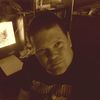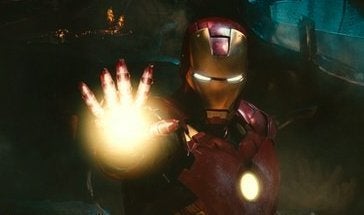
For over three decades, John Nelson has specialized in making impossible images seem real. The University of Michigan graduate has worked on films ranging from The Pelican Brief, In the Line of Fire, I, Robot and Iron Man. One of his more memorable effects can be seen in Terminator 2: Judgment Day, where animated the moment where Robert Patrick's head recovers from a shotgun blast. Nelson has even won an Oscar for his work on Sir Ridley Scott's Gladiator.
Because he's made a career of making both subtle and spectacular effects look effortless, he was an ideal choice to supervise the visual effects in The Sorcerer's Apprentice, which comes out on DVD and Blu-Ray on November 30. The film stars Jay Baruchel as Dave, an NYU student who reluctantly becomes the pupil of a master sorcerer named Balthazar Blake (Nicolas Cage). The two have to defeat Balthazar's arch rival Maxim Horvath (Alfred Molina) in order to prevent New York from experiencing an apocalyptic meltdown.
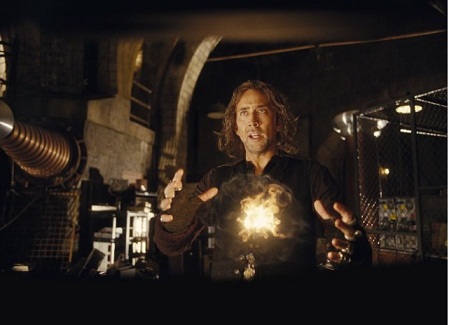
Balthazar (Nicolas Cage) demonstrates how to form a plasma ball. Photo by Robert Zuckerman -© Disney Enterprises, Inc. and Jerry Bruckheimer, Inc. All rights reserved.
For the film, Nelson and his crew had to make the bronze statue of the bull on Wall Street, an eagle from the Chrysler Building and a Dragon in a Chinatown parade come to life. In a virtual roundtable held on November 18, Nelson typed back answers to questions other journalists and I submitted through a private chat room. Even though he's worked with state of the art equipment for companies like George Lucas' Industrial Light & Magic and Sony Pictures Imageworks, he's consistently quick to acknowledge how his forbearers like Ray Harryhausen (Jason and the Argonauts) have influenced him.
What's most difficult to create and animate: fire, fluid water or creatures like that tiny animated dragon?
Animated characters like the little dragon need to act and are animated by character animators. Fire, water and the like are done with a technique known as fluid dynamic simulations. The simulations are tricky because they are not animated but governed by constraints and you can get everything right and then change one of constraints and have it look completely different.
For the little dragon, the challenge was to get the performance of the little guy while also keeping the metal looking like metal and not have it turn into plastic. I think he looks like real metal and gives a good performance.
Would you say that today's CG FX are more dependent upon a supervisor's technical knowledge, artistic knowledge, or a third field I haven't even thought of?
Being a good filmmaker is the most important as you will know what will work cinematically. Next, knowing what you what creatively from the effect and how to achieve it technically. Finally, knowing the latest techniques and knowing what process is best to achieve your goal is also important (in addition to about a thousand other things).
When you're animating something as high-tech looking as The Sorcerer's Apprentice, do you ever think back to the Ray Harryhausen era and marvel at how far visual effects have come? What would you say is responsible for the biggest leap in the creation of visual effects?
I am amazed all the time at what Ray did with his way of doing thing with little more than himself shooting actors and then animating stop motion characters in front of those rear projected backgrounds. I think many in this field were inspired to do what we do by seeing Ray's films and films like 2001.
When I am tired from working 18 hours a day and a bit down, I often think of the fact of how easy I have it because I have all these tools, tools that the old masters like Ray did not have. Creative solutions never go out of style. That is why Ray's films still captivate audiences. I look at the old films like Tora! Tora! Tora!, Darby O'Gill or The Wizard of Oz and still love them.
Of the movies you haven't worked on, which do you think contain the most enviable visual effects, and why?
I loved 2001, Star Wars, Close Encounters, Spartacus, Darby O'Gill, The Aviator, Pirates (of the Caribbean: At World's End)" (Davy Jones' face!), District 9, Inception, Avatar, in addition to many others, both old and new.
What makes me like a film with VFX (visual effects) is when I see clever filmmaking combined with realistic visual effects in a package that is solid storytelling. That can mean using an old effect in a new way or using a new effect to show something that hasn't been seen before. The key is to be like a master musician and play just the right notes at just the right time.
Roger Ebert singled out the scene where the dragon in a Chinatown parade and a steel eagle on top of the Chrysler Building come alive. Can you talk about the strategies and/or challenges of creating those scenes?
The Chinatown dragon was hard because of the crowds involved and the magic we were doing had many forms. First, the sorcerer Sun Loc had to come out of the grimhold as a thousand butterflies that formed his body, then he had to bring the dragon on his breastplate to life and make it crawl off the breastplate and under his skin, then the paper dragon with people holding it had to turn into the real dragon, then the dragon had to chase Dave throughout Chinatown.

Balthazar (Nicolas Cage) gets ready to hitch a ride on a metal eagle. Photo by Robert Zuckerman -© Disney Enterprises, Inc. and Jerry Bruckheimer, Inc. All rights reserved.
For each of these steps, our approach was to shoot our background plates with the actors as quickly as possible and also shoot references of what the real dragon skin might look like, in addition to clean plates and high dynamic range stills (and do all that as quickly as possible!). That way, when we go to create the VFX in the computer we have all the tools and photographic reference to achieve realistic images.
Beyond that it is the acting experience of the animators that bring the digital characters to life. The process was similar with the Chrysler eagle, but its surface was metal and needed to appear as metal and not bend like skin or plastic.
Could you explain how you put together the Tesla coil scenes?
We reviewed real Tesla coil footage and even shot some ourselves. Next, we picked a song that the coils were to fire in sync with. Next we rigged a computer controlled lighting rig to fire interactive lights in sync with the music. Then we shot our backgrounds with the actors in that interactive light and went into post production.
In post production, we animated the Tesla coil arcs to match the music and interactive lights. We had to change some of the timings to make it work but because we shot clean plates and had a complete digital copy of the set it was possible to do this.
What was your contribution to Iron Man?
I was the Senior Visual Effects supervisor and responsible for every visual effect in the film. I had the same role on Sorcerer's Apprentice.
Can you talk about the intersection of visual effects, acting, and direction?
The director directs all components of the film including visual effects. Directing the actors in a big visual effect sequence is demanding though in that you need to explain what the actors can see and what they can't see--but will be added later so they can have a complete understanding of what it will ultimately look like. I particularly like to work the effects off the physical actions of the actors. It makes the effects more organic and character driven.
Do you ever worry that the explanations you provide for the effects, like the ones we're watching now from the DVD, might reduce a viewer's awe at seeing a metal bull or a dragon?
Sometimes I feel like a magician giving away the secrets but I feel the people who view these explanations want to see what goes on behind the Wizard of Oz's curtain.
The vehicle chases in The Sorcerer's Apprentice look pretty complicated, too. Where they tough to pull off?
We had to shoot all of the car chases going no more that 25 MPH because on our first night of shooting a car had a slight mishap 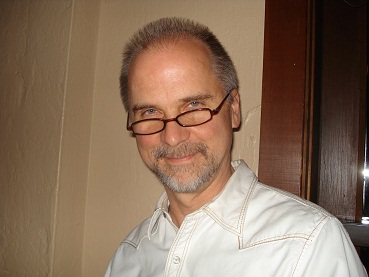 and one of our cars slid into sandwich shop window at midnight. No one was seriously hurt.
and one of our cars slid into sandwich shop window at midnight. No one was seriously hurt.
What we had to do was speed up all the chase stuff after that and add digital cars and props where necessary. In some sequences, we created totally digital sections of New York so we could destroy it and when necessary reverse explosions, etc. Mirror world was particularly difficult in this way.
It was a tremendously complex task that worked upon the stunt driving of George Ruge's stunt team driving backgrounds and that were passed off to the talented animators at Asylum VFX (where lots of fully digital shots were added) to pull it off.
How many of the effects in The Sorcerer's Apprentice were CGI and how many were on-set practical effects and which type of effect do you prefer to work with?
I love to mix up practical effects with visual effect (usually made from CGI). The mix gives the effects more realism and uses the best parts of each technique to make the finished effect more real while also being able to achieve the fantastic.
With Terminator 2, you were one of the pioneers with using CGI. How has the technology evolved?
Computer generated imagery is much more real now. With the advent of image-based rendering (where we shoot high dynamic range stills of each background and used them to light the CG objects), realism has taken a large step forward.
I assume, when you started your career, you were mostly dealing with practical effects, because of the given technical options. Does that experience influence your approach in your work as a VFX supervisor today?
I really have been doing computer graphics for visual effects since 1983 so my career has paralleled the advance of CGI in our industry. I feel CGI can do anything but it is also the most complex and expensive way to achieve something. I come from being a cameraman so I like to photograph things. The easiest way to get a photoreal picture is to photograph something. That is why I like to use as many real photographic elements as possible and only use CGI to get to achieve the stuff I can't photograph.
What type of special effects do you specialize in?
I love the ones that are real and also elegant in the way they achieve their goals. History and comic books have always been an interest of mine, so comic-related and history-related projects have always gotten me going. Really good stories get me going.
One of the things I love about my job is that I get to research the reason why an effect might be useful to a story and then incorporate that reasoning into the way the effect works. In Sorcerer's Apprentice, we did this by saying the electrical charges the sorcerers can conjure are an extension of their neurological system which is electrically based. It is how we send signals from our brain to move our feet, etc. The only difference is that for our sorcerers, their neurological system is highly refined to channel large amounts of electricity.
The Pelican Brief and In the Line of Fire don't come to mind as special effects movies. What sort of effects did you work on for these films?
For Pelican Brief, we did a Lear jet in the clouds at night (something that would be hard to photograph) and for In the Line of Fire, we shot political rallies of Bush and Clinton, removed Bush and Clinton, and added Clint Eastwood and other characters from our story. People said these rallies looked real because they were real.
What did you first think you might do when you got this job to do VFX on this film and what changed from that in the final filming? Is it normal on all films to change ideas as you film or do you always have a good hand on what you will do before you shoot the first scene?
The script is always changing but the ideas behind the script tend to be somewhat constant. You read the script and design the VFX work to satisfy the needs of the script and prep with all the other departments (stunts, camera, art dept, practical effects) to be ready so when we shoot the pages of the script all the components work together to work as well as possible and be shot as quickly as possible.
In post production, we will add what we need to but with each day of principal photography costing so much money, we try to get as much in the camera as we can! It is important to define what is important about the effect and have a firm idea of how to achieve that so when the specifics change you will be able to quickly re-organize your mind to get the correct photographic plates (background with actors).
You can draw it or pre-visualize it and all of that helps especially for extremely complex work. The actual shots are defined when the director sees the actors rehearse their actions and then everything is adjusted to work how he wants to cover it.
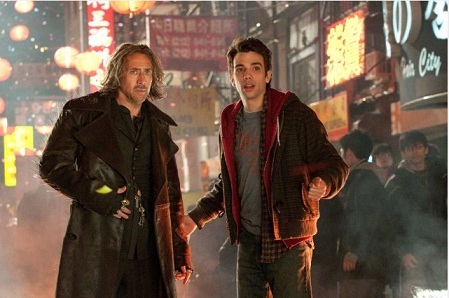
Balthazar (Nicolas Cage) and Dave (Jay Baruchel) attempt to stop a real dragon running amuck in Chinatown. Photo by Robert Zuckerman -© Disney Enterprises, Inc. and Jerry Bruckheimer, Inc. All rights reserved.
1251 VFX shots seem impressive -- do you know which movie is the record holder in that department at the time? How many VFX shots were in that record and what's the average of VFX shots per modern theatrically released movie?
In the old days a 400 shot show was a lot of VFX shots. Now the big films usually have over 1000 shots. The biggest ones are shows like Lord of the Rings or the new Star Wars films which have 1600 or more. Of course, Avatar reached new heights as every shot was a visual effect shot.
Why do some CGIs look convincing while others look as if they've been made from a PlayStation 2?
Usually realism depends on how well the backgrounds (and what reference) were shot combined with using CG techniques such as advanced lighting models that use high dynamic range imagery for image based rendering. Getting the spectacular reflections (the sheen reflected off the surface of an object) correct is the most important thing in making a CG object look real. Also keeping the digital camera moves looking like something a real camera could do is very important.
